
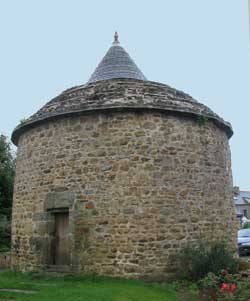 |
Dovecote of HillionWe located the dovecote at Hillion quite serendipitously because it is not mentioned in our guide book Colombiers et Pigeonniers en Bretagne Profonde. We were driving through the town, when we spotted it, right next to a public parking lot. It is not the largest of this beehive type, having just under 600 nest holes in 19 rows using the standard checkerboard pattern with holes rotating from left to right by row. There is a pedestal that undoubtedly used to hold a potence, but has been modified into a table with a new stone top. It is logical that the pedestal originally supproted the potence, since it is in the middle of the dovecote,and since the dovecote is round. The height of the pedestal is also correct.. Squabs from the lower nestholes would have been collected by hand and those in the higher nestholes via the revolving potence. The cupola is slate, and the entire structure has been nicely restored. This dovecote is a very good example of the round beehive type dovecote. The area to the west of Hillion sports several of this type, and. would have been included on the quick trip tour, except that the beehive type dovecote at |
| Hillion Dovecote |
|
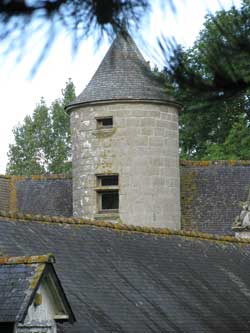 |
| Plesidy Dovecote |
The manor is located a little before the borough of Plesidy when traveling south on the D5. It is a most interesting manor, with the dovecote built directly as the upper part of the manor’s stair tower. The pigeon cote is located at the top of the tower, and is rather small, with only 76 nest holes. One of the unmistakable identifying marks from the exterior is the small access window with a landing board. Since the tower is capped with a solid pepper conical roof, the entrance window and ledge was the only means for the pigeons to gain access to their home. We found a another dovecote incorporating a similar construction design concept at La Ville Roze.
The house with dovecote dates from 15th or 16th centuries and is perfectly representative of the noble architecture of its time in Brittany. It was classified as a historic building rather early, on May 28, 1927.
The house is on private property, but it can be seen rather easily from the road, as the tower extends well above the roof line.
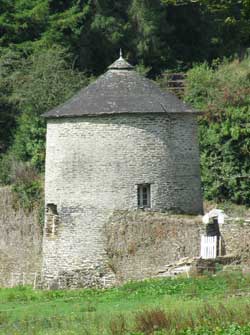 |
| Pratulo Dovecote |
The castle of Pratulo’s dovecote is round and capped with a slate roof that is further capped with a small slate cover cupola with a decorative spindle. One very unusual feature of the dovecote is the side door about 8 feet above the adjacent lower level field below. This feature allowed the easy evacuation of the manure into the garden plot below.
Pratulo formerly belonged to the Glaz family, of Scottish descent. Jean Glaz was noted in 1562 as being an arquebusier with horse. The name Pratulo came with the marriage of Marguerite de Pratulo to the son. Another daughter married George de Musuillac, lord of Kerdréan, and the castle remained the hands of the Musuillacs for two centuries.
The dovecote is on private property, and the lane to the home becomes private as well. But you can still get a glimpse of the dovecote by traveling SW of Cleden-Poher on the D217 for about 3.4 km, and making a right turn immediately before crossing the bridge over the Aulne. Proceed up the lovely lane with public road signs, until it is marked as private. You can see the dovecote from this spot, so you need not trespass by traveling any further.
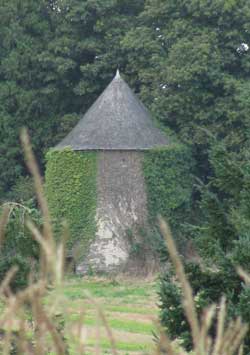 |
| Kergoat Dovecote |
From Dr. Jean Auffret, we learn that Kergoat was known as an important seat during the episode of the revolt of the red bonnets and the revolt of the stamped paper. The Bishop of Saint-Malo noted that the castle of Kergoat was one of the strongest houses of Low Brittany on July 23, 1675, and at that time it had a fortress type enclosure in which one would find not just one, but two dovecotes. A very unusual, and a very strong symbol of power indeed. Unfortunately, today only one remains.
This lovely dovecote is also on private property, but it can be seen from a public road. The view in the photograph was obtained from the D82 about .3km SW of the turn to Kergoat. It is of the more typical beehive design for the area, but rather taller, and therefore larger than most. From scaling the entry door, one can estimate that the dovecote is between 25 and 30 feet in height to the eves of the slate roof. There is no entrance cupola and so, from this view, it is not known how the birds gained access. While the structure is currently in good condition, as evidenced from the photograph, the strong growth of ivy, while picturesque, will damage the dovecote if not properly removed soon.
The Nantes - Brest canal flows near the dovecote, and provides a lovely place for a nice picnic. We had a charming picnic lunch there, shared with us by a friendly dog. Perhaps the same nice yellow retriever will picnic with you. He is particularly fond of brie, but is very polite and waits until it is offered.
We were unable to get to the area north of St. Brieuc, but Dr. Jean Auffret reports on these in Colombiers et Pigeonniers en Bretagne Profonde. We have provided small thumbnail images from the book to help you identify them. More detail on these pigeonniers/dovecotes and larger images are in the book, which we highly recommend for any enthusiast.
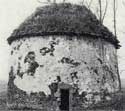 |
The dovecote of Saint-Yves Treguier belonged since 1250 to Hélory de Kermartin, husband of Azon of Plessix, father of Saint Yves who built it. The manor has been destroyed by fire and more recently replaced by a farm house. . The pigeoncote is rather simple and without ornamentation. Much of the old exterior "plaster" coating remains on the exterior surface. The interior has twenty-four rows with 30 nestholes per row. It is located about one hundred meters to the south-west of the farm house. |
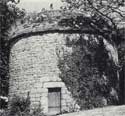 |
The dovecote of the manor of the Green Noe in Lanloup dates back to 1220 and is presumed to have belonged to Auffray de Goez-briand. In 1418, the owner was Sylvestre Boisgelin. The dovecote is still in use, at least ornamentally sheltering a few pigeons, whose presence accentuates the charm of the remarkably renovated manor. |
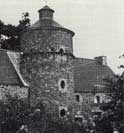 |
The dovecote of the manor of Fountains (Saint Quay Portrieux), of the 16th century, is built into the manor similar to the one found at Plesidy above. However, this is rather an enormous dovecote of this type, complete with a rat course hoped to prevent the rodents from climbing up the wall, as well as being an architectural enhancement and used as a promenade by the birds. |
The next day we continued our journey in the Vicinity of Morlaix and St. Pol de leon on our way to our second lovely gite in Locronan. ![]()
DAY |
||||||||||||||||||
| 00 | 01 | 02 | 03 | 04 | 05 | 06 | 08 | 09 | 10 | 11 | 12 | 13 | 14 | 15 | 16 | 17 | 18 | |